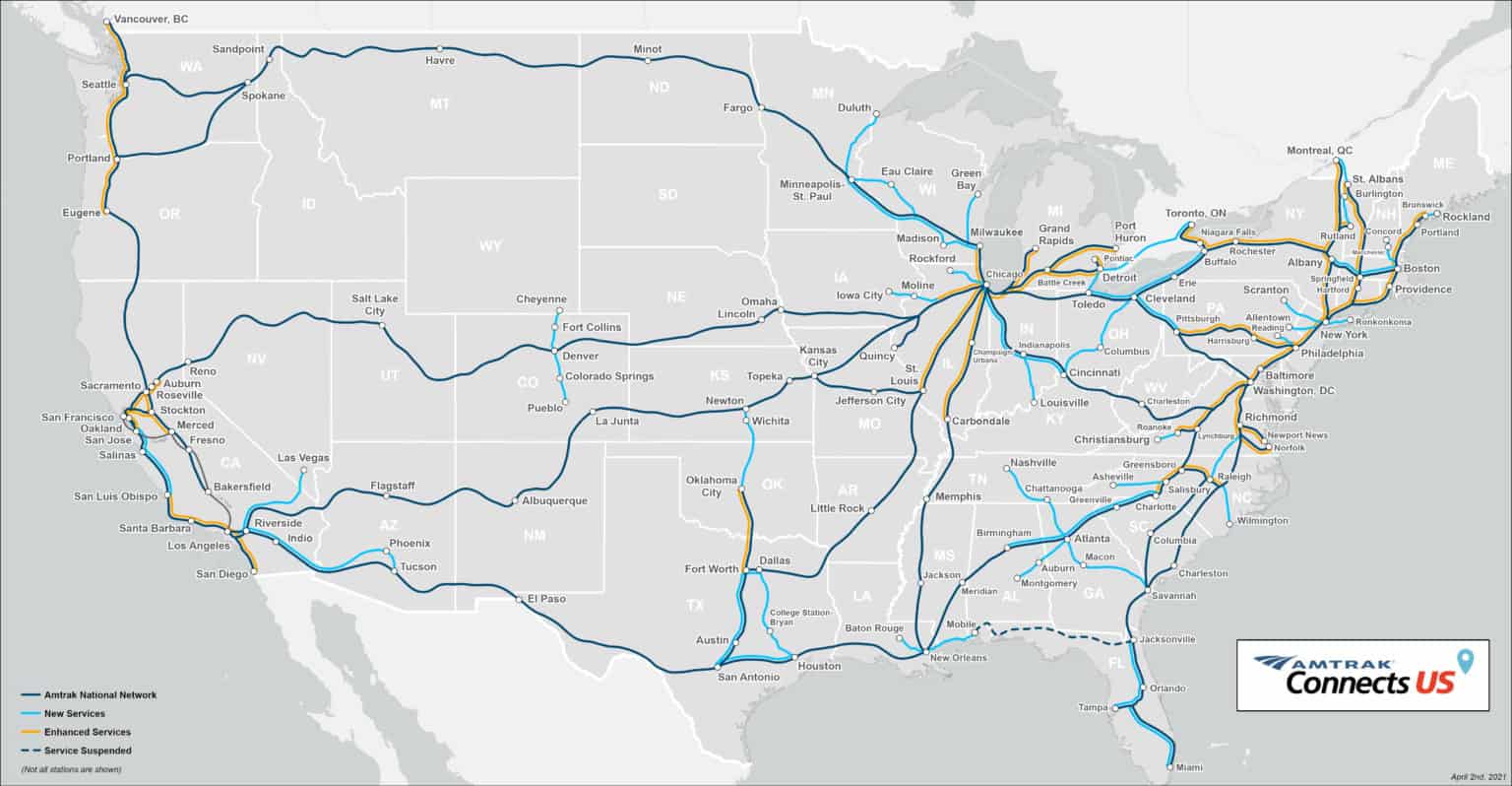Amtrak Connects US

1. Creating billions of dollars of economic growth across the country and thousands of good paying jobs.
WASHINGTON – Amtrak is initiating the work to deliver by 2035 more frequent, reliable and sustainable intercity passenger rail service to over 160 more communities and 20 million more passengers annually, as outlined in the Amtrak Corridor Vision released today. To be implemented in collaboration with states, local communities, the administration and many other stakeholders, the Corridor Vision builds upon Amtrak’s national network, integrating new and improved corridors to expand the existing system.
“Now is the time to invest in our country’s infrastructure and future,” said Amtrak CEO Bill Flynn. “New and improved rail service has the ability to change how our country moves and provides cleaner air, less traffic and a more connected country.”
Amtrak’s vision to grow rail service across America includes 39 potential new routes and more trips or other enhancements on 25 existing routes, creating the potential to expand or improve rail service for 20 million additional passengers each year. The plan calls for improved service in major cities currently underserved by rail like Houston, Atlanta and Cincinnati and new intercity passenger rail service to cities such as Las Vegas, Nashville, Columbus, Phoenix, and Wichita, with increased access for many towns and cities in between.
The economic benefit of Amtrak’s Corridor Vision is expected to reach $8 billion annually by 2035, with an additional $195 billion in economic activity generated by additional capital investment during 2021 – 2035. More than 26,000 ongoing permanent jobs plus 616,000 person-years of employment supported by capital investments during 2021-2035 will be created or supported by this vision.
Additionally, this plan offers a significant opportunity to reduce emissions. Travel on Amtrak trains outside the Northeast Corridor (NEC) emits up to 55% fewer Greenhouse Gases than driving alone, and up to 30% fewer than flying.
In a letter to Congress, Amtrak highlights what it will take to achieve this bold vision.
Flynn added, “The American people have waited long enough for a sustainable, world-class intercity passenger rail network. Congress could pass legislation today to start making Amtrak’s vision a reality: create a Corridor Development Program, pass the Intercity Passenger Rail Trust Fund Act and Rail Passenger Fairness Act, and clarify the law to ensure fair access to host railroads for Amtrak growth.”
Information about the national plan can be found at AmtrakConnectsUS.com
2. By 2035 Amtrak wants to deliver more frequent and reliable trains to more Texas cities
This would be especially true in Texas as more than 1,000 new residents move to the state every day. Expansion of train service between Texas towns and cities would result in economic growth for the areas served and additional jobs as Amtrak would beef up service in corridors generally under 300 miles.
- Amtrak proposes extending one Fort Worth-Oklahoma City roundtrip to Wichita and Newton, Kansas where it would connect to its Southwest Chief Chicago-Los Angeles route
- Two additional round trips between Fort Worth and Oklahoma City to supplement the once-daily Heartland Flyer service
- Two additional round-trips between Dallas-Fort Worth, Austin and San Antonio to supplement the daily Texas Eagle, operating from Chicago to San Antonio with tri-weekly service on the Sunset Limited onward to Los Angeles
- Three daily round trips between Houston and San Antonio
- Reinstituting service between Dallas and Houston via College Station with three round trips daily on a route that was cut in the late 1990’s
Amtrak President Stephen Gardner and CEO Bill Flynn call the Heartland Flyer expansion project a high priority, both saying it would add between 100,000 and 200,000 riders annually and have an estimated $64.8 million annual economic impact.
Amtrak, which has right of access to all railways in the U.S., would need to work with freight railroads to add capacity such as additional track, signals and other infrastructure improvements.
A presentation October 15, 2021 by Amtrak Government Affairs indicated that, with federal support, Amtrak would pay for up-front infrastructure needs on any new corridor service. Federal operating support for new corridor service could be up to the following share of state operating costs for the first 6 years of service:
- YEAR 1 - 90%;
- YEAR 2 - 80%;
- YEAR 3 - 70%;
- YEAR 4 - 60%;
- YEAR 5 - 50%;
- YEAR 6 - 30%;
By this means the up-front costs of getting the service started would be bourn by Amtrak. As ridership and revenue build over the first 6 years, the state would start picking up the share of operating support. It’s a win for states that want passenger rail service but can’t afford the large upfront costs.
3. Letters of support from elected and appointed officials
Houston to San Antonio (I-10 Corridor) Amtrak expansion support:
- Houston Mayor Sylvester Turner Letter of Support
- San Antonio Mayor Ron Nirenberg Letter of Support
- San Antonio City Council Resolution for Daily Amtrak Service
- Texas Senator Kolkhorst Letter of Support to Congressman McCaul
- Texas Representative Leman Letter of Support
- Fayette County Judge Weber Letter of Support
- Flatonia Mayor Milson Support Letter
- Flatonia Special Projects Amtrak Letter
- What daily service in the Sunset Limited San Antonio-Houston Corridor will mean for Texas
San Antonio-Austin-Fort Worth (I-35 Corridor) Amtrak expansion support:
4. Links to News Stories / Posts
- 4/5/2021 – TRA Newswire – Biden/Buttigieg $80 billion for rail, Amtrak announces Texas expansion plan
- 4/7/2021 – KBTX.com – https://www.kbtx.com/2021/04/07/amtrak-considers-adding-new-bryan-college-station-stop-on-route-connecting-texas-triangle/
- 5/27/2021 TRA Newswire – Amtrak on push for intercity rail service expansion: Houston, other Texas cities in “triangle”
- 6/8/2021 – NBCDFW.com – Amtrak, local leaders discuss possible Midwest Expansion, including added Fort Worth frequency
- 10/4/2021 – SpectrumLocalNews.com – https://spectrumlocalnews.com/tx/south-texas-el-paso/transit/2021/10/04/amtrak-eyes-major-expansion-in-texas-
